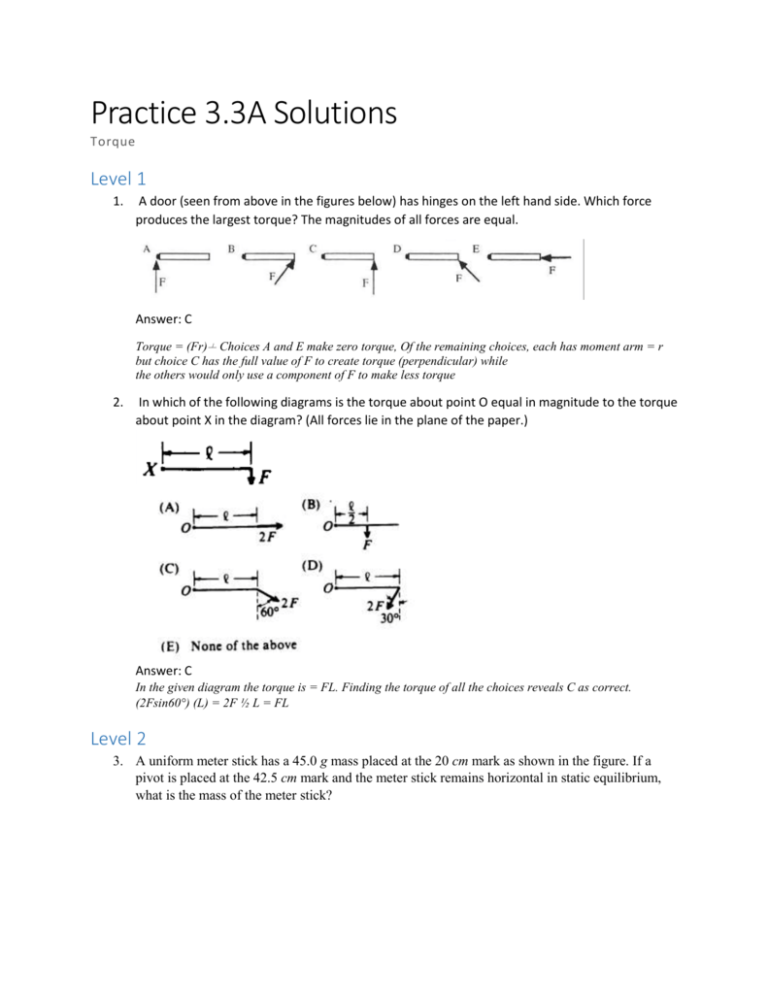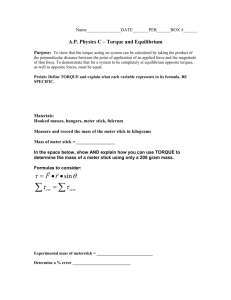Practice Torque Solusions
advertisement

Practice 3.3A Solutions Torque Level 1 1. A door (seen from above in the figures below) has hinges on the left hand side. Which force produces the largest torque? The magnitudes of all forces are equal. Answer: C Torque = (Fr)┴ Choices A and E make zero torque, Of the remaining choices, each has moment arm = r but choice C has the full value of F to create torque (perpendicular) while the others would only use a component of F to make less torque 2. In which of the following diagrams is the torque about point O equal in magnitude to the torque about point X in the diagram? (All forces lie in the plane of the paper.) Answer: C In the given diagram the torque is = FL. Finding the torque of all the choices reveals C as correct. (2Fsin60°) (L) = 2F ½ L = FL Level 2 3. A uniform meter stick has a 45.0 g mass placed at the 20 cm mark as shown in the figure. If a pivot is placed at the 42.5 cm mark and the meter stick remains horizontal in static equilibrium, what is the mass of the meter stick? (A) 18.0 g (B) 45.0 g (C) 72.0 g (D) 120.0 g (E) 135.0 g 4. A uniform meterstick is balanced at its midpoint with several forces applied as shown below. If the stick is in equilibrium, the magnitude of the force X in newtons (N) is (A) 50 N (B) 100 N (C) 200 N (D) 300 N (E) impossible to determine without the weight of the stick As above, apply rotational equilibrium + (300) (30cm) – X (20 cm) – (200) (40 cm) = 0 5. A meterstick is supported at each side by a spring scale. A heavy mass is then hung on the meterstick so that the spring scale on the left hand side reads four times the value of the spring scale on the right hand side. If the mass of the meterstick is negligible compared to the hanging mass, how far from the right hand side is the large mass hanging. (A) 25 cm (B) 50 cm (C) 67 cm (D) 75 cm (E) 80 cm 6. For the wheel-and-axle system shown, which of the following expresses the condition required for the system to be in static equilibrium? Answer: B Simply apply rotational equilibrium (m1g) • r1 = (m2g) • r2 m1a = m2b Jedi 7. Two objects, of masses 6 and 8 kilograms, are hung from the ends of a stick that is 70 cm long and has marks every 10 cm, as shown. If the mass of the stick is negligible, at which of the point indicated should a cord be attached if the stick is to remain horizontal when suspended from the cord? (A) A (B) B (C) C (D) D (E) E To balance the torques on each side, we obviously need to be closer to the heavier mass. Trying point D as a pivot point we have: (m1g) • r1 ?=? (m2g) • r2 (6kg) (40 cm) ?=? (8kg) (30 cm) and we see it works.











